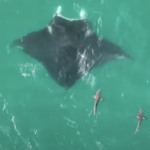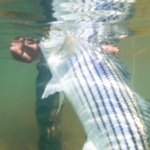
Veteran Florida Guides Concerned About False Albacore
While the ASGA team is extremely proud of the community we’re building with the Guide
By Capt. John McMurray
Before getting to striped bass, certainly, there was some good news to come out of this week’s Atlantic States Marine Fisheries Commission meeting.
The menhaden reduction industry, specifically one notorious company in Virginia – Omega Protein, which accounts for over 70% of menhaden landings along the Coast – had essentially thumbed their nose at the Commission and willingly exceeded a cap on landings in the Chesapeake Bay, put in place by the Commission several years ago.
The intent of such cap, which was based on the prior 5 years’ average landings, was to avoid localized depletion and the effects large-scale harvest might have on the Bay’s ecosystem. I don’t think we need to mention it here, but menhaden is of course one of, if not THE most important forage source for striped bass, bluefish and just about every other marine predator with fins or wings. So it certainly makes sense that if you take an extraordinary amount of menhaden out of what is THE most important estuary on the East Coast, there will be negative effects.
Yet, there has been push back by Omega on the cap from the beginning, claiming that it wasn’t based on science, that it wasn’t necessary for the conservation of the species etc., all things that are intuitively incorrect. A complicating factor here is that menhaden is managed by the Virginia state legislature not Virginia’s Department of Marine Resources. As big companies often do, Omega has been able to “influence” legislators and there hasn’t been a successful vote to codify the cap. Thus, their argument was that they could exceed the cap and still be well within the law.
That’s not true though. Virginia is bound by Atlantic Coastal Fisheries Cooperative Management Act, and should such a state be found out of compliance with the fishery management plan the decision gets bumped up to the Secretary of Commerce, which, if it agrees with such a finding, could declare a moratorium on menhaden landings in the state until the state comes into compliance.
A few notes here. It’s good that the Commission had the guts to stand up to Omega. There was certainly a question as to whether or not it would. The Commission is rightly worried about whether or not the Secretary of Commerce will undermine it’s decision, given it’s acquiescence to New Jersey after a non-compliance finding back in 2017. That was the first time ever a Secretary of Commerce didn’t support a compliance finding. And it sure appeared like it was a political favor for a Governor with a good relationship to the current Administration.
What happens this go-around is anyone’s guess. But we’re hoping that this Administration will see the folly in allowing a Canadian owned company to thumb its nose at the Commission, and pretty much tell us it’s gonna do whatever it wants. It would be good if some of these recreational fishing organizations with strong lobbies on Capital Hill started pounding on some doors (i.e. ASA, CCA, TRCP etc.) but it’s anything but certain that will happen.
Stay tuned…
No matter how you cut it, things went bad here.
Just to recap, the striper stock is “overfished” and “overfishing” is occurring. What that means is that we are above a fishing mortality threshold and under a female spawning stock biomass threshold set by scientists.
As a result, the Commission’s Striped Bass Board initiated Addendum VI, which requires an 18% reduction from 2017 removals.
The first decision point on the Addendum was whether or not to require equal reductions from both the commercial and recreational side, or “proportional” reductions based on the amount of fishing mortality each sector was responsible.
Option 2 required equal 18% reductions.
Because the recreational side is responsible for 90% of removals and the commercial side 10%, Option 3 would have required a 20% reduction on the recreational side, and a 1.8% reduction on the commercial side.
Option 2 won the day, with the great majority of the Commissioners voting in favor if it. Some reasons for support included that this is a shared resource – all sectors should do their fair share to end overfishing and to rebuild the stock. Under option 3, ninety-nine percent of the conservation burden would be on a sector that is responsible for only 90 percent of the mortality. And, that such option would effectively reflect a reallocation.
Next, the Commission dealt with size and bag limit alternatives. Despite the fact that the great majority of the public had clearly advocated for the most conservative, time-tested option – 1 fish per angler at 35” – the board voted for what we consider to be the most risky option of 1 fish from 28 to 35”.
For sure there could be some benefit to protecting all those larger, older fish, north of 35”, but from a practical perspective, it makes little sense to focus fishing mortality on the handful of year class that fall within that 7” slot limit.
One of the main arguments for such a slot is that it would still allow anglers to take home a fish, while protecting a significant amount of the older, larger fecund females. A few things here though. The entire point of the Addendum was to reduce fishing mortality. In other words, the intent is to make it more difficult to bringing home a fish. But also, if all the fishing mortality is focused on those smaller fish, well, a lot of, perhaps most fish won’t make it to the 35”-plus safe zone, rendering any conservation benefit moot. Also, it’s pretty clear that discard mortality (those fish that die after release) is considerably higher on those older, larger fish. None of all this was considered in staff’s analysis. Lastly, the public comment period made it pretty clear that the majority wanted one fish at 35”.
While it seemed clear this was the most risky option, the Commission chose the 28 to 35” slot limit. And that’s okay, because the truth is, we really don’t know how such a slot limit may work out, because a coastal slot such as this has never been tried. It may very well protect a lot of larger older fish and have a real effect on increasing spawning stock biomass. While optimism might not be the right word to use, we do hope this is the case.
That said, things quickly went south as the conservation shifted to “conservation equivalency”. If you’re not familiar with that term, conservation equivalency – which is currently built into the fishery management plan, allows states to develop their own regulations as long as they achieve the same reduction as the 28 to 35” slot limit does.
In this case, however, because every state’s 2017 landings were different, such a slot limit would result in a different reduction in each state. In the end though, those reductions would add up to the required 18% coastal reduction described in the Addendum. We aren’t quite sure what the reductions in each state would be yet, but it’s safe to say that because New Jersey catches so many fish, their reduction would be more significant.
So the New Jersey delegation, which seems to want to grab as many fish as it can, and to hell with the intent of Addendum VI, inserted language in the motion that requires each state to reduce 18% with it’s conservation equivalency proposals, instead of the reduction a one fish at 28 to 35”limit would achieve in the relevant state.
I know this is complicated, but what it boils down to is that if states do conservation equivalency proposals at an 18% reduction, when their actual reduction would have been significantly more under the 1 fish at 28 to 35”, then the total reduction along the coast won’t add up to 18%. In other words, there’s now a really good chance this addendum won’t adequately address overfishing, and it won’t fully rebuild the stock. And that’s unfortunate.
The February meeting should be a real (expletive)-show as states South of New York try and squeeze as many fish as they can out of the situation with some “creative” conservation equivalency proposals.
What this all points to is that the entire idea of conservation equivalency is a cancer at the Commission. Not just in this case, but certainly in prior years with striped bass.
The intent of course was always to give the states some flexibility to develop regulations that worked better for their states – and we wouldn’t be opposed to that – but what it’s evolved into is a way for states to game the system and offer proposals that may work on paper but in the real world all they do is increase harvest for their fishermen.
Still… that would be okay too if there was some accountability when such regulations didn’t work. In other words, if states such as Maryland went way over their harvest limit because their conservation equivalent programs didn’t work, well then they would have to adjust regulations the next year, not just to stop the overfishing, but to pay back what they’ve overfished.
But that’s currently not how things work. And that needs to change.
States are required to submit implementation/conservation-equivalency plans by November 30th for review by the Commission’s Technical Committee. The Striped Bass Board will look at them in February 2020.
What remains in question is how the Board will deal with states who submit plans that achieve an 18% reduction, but not the reduction required to meet the coastal requirement. And that will be interesting. I mean, is the Board really okay with not achieving a coastwide 18% reduction?
And then there’s the issue of Conservation Equivalency proposals themselves. We’ve seen some pretty whacky stuff. Like “no fishing after 10am”. Not sure how such things can be quantified. And it’s no secret that at least one state has threatened to go out of compliance should their equivalency proposal not be accepted.
As an aside, the board also voted that states must implement mandatory circle hook requirements for anglers fishing bait by January 1, 2021. It’s not news that such hooks reduce discard mortality, and they should be a requirement. Kudos to the Commission for that.
It’s important to mention here that in May, the Board will consider a motion to initiate a new striped bass amendment “to rebuild spawning stock biomass to the target level” and address “other” issues with the management program.
This can be good or bad, depending on how things go down. Maryland and Delaware have made no secret of the fact that they would like to use such an amendment to “adjust” the fishing mortality and spawning stock biomass reference points to address a “decrease in productivity” in the Chesapeake Bay. Without getting into too much detail here, what that means is they would like to lower the goalpost on what a healthy stock looks like. And that will be a tough battle moving forward.
That said, some of the New England states have argued that it could also be a chance to make the reference points more conservative. Given the Commission’s track record though, I find that very unlikely.
What this Amendment will most certainly do however, is take a really good look at “conservation equivalency”, and I would be surprised if there wasn’t real discussion here on getting rid of such a program all together, or at the very least require some accountability.
Again… Stay tuned.
The commissions decision to find Virginia out of compliance was a real win. It showed that the Commission still has solid management authority over the states. Yes, there’s a good possibility that the Secretary of Commerce will side with industry on this one, but there’s also a good possibility that he won’t.
In any case states got the message loud and clear that the Commission won’t just roll over when a state – or in this case one company within a state – decides it’ll do whatever it wants and to hell with the other states. And that is a good thing, especially in the context of rumors that Maryland might go out of compliance with striped bass, should the Commission fail to approve their conservation equivalency proposal.
With striped bass, this was supposed to be a cut and dry amendment. Despite whatever option you might have favored, they all technically got us a significant 18% reduction, which is badly needed to get striped bass back to where it needs to be. Unquestionably, the state of New Jersey dropped a wrench in the gears. We could be wrong here, but this will make things VERY difficult in February. And all of this shines a bright light on why we either need to get rid of conservation equivalency altogether, or tweak it so such problems don’t arise, and there’s some accountability.
Stay tuned as there’s still A LOT to be determined.

While the ASGA team is extremely proud of the community we’re building with the Guide

Feature Image: A false albacore being landed off Jupiter Florida by the Cheeky Fishing team,

Feature Photo: “Best Practices for Fishing Cobia Around Manta Rays” The Florida Manta Project is

We caught this article a few days ago. Here’s the summary: Maryland striped bass commercial
We rely on our members and donations to keep fighting for a sustainable tomorrow in marine conservation.
By using this website, you agree to our use of cookies. We use cookies to provide you with a great experience and to help our website run effectively. To learn more, please review our privacy policy.
10 Responses
While I agree with most for your sentiments your math doesn’t work John. If every states achieves the 18% reduction then the coastwise reduction will be 18% (leaving out the Chesapeake bay fishery whereto reduction is planned to be less than 18%.) It is trues that some states, would have a greater than 18% reduction if CE is not implemented, but if there was no CE then the coastwise reduction would be greater than the target 18%. The real shame here is that the board only selected options which have a 50% (coin flip) chance of curing the underlying problem.
John’s math is correct Mike. I will write more over the weekend. It would be really great if I could spend some time with my family tonight. So, I am going to focus on them and not give a full reply to your statement right now. We won’t approve any comments on this until we can give them the time they deserve.
Mike, As specifically worded both John’s math, and your math are correct. The crux of the matter is that your math makes an assumption which is untrue: “If every states achieves the 18% reduction”.
Not all states are required to, nor are they all planning to, submit Conservational Equivalency proposals.
When the assumption that “every state achieves the 18% reduction” is removed from the equation, the percentage of total coastwise removals will be other than 18%.
In this case it will most likely be lower than the required 18% because it’s logical to assume that only the States that will experience a reduction greater than 18% individually under the slot limit, will be the States submitting CE’s.
True enough, but I don’t think that distinction is getting through to the public, and it should. Because the public is the force that can drive the states to adopt more stringent regs than the ASMFC requires.
Agreed Mike, that distinction is most certainly not getting thru to ‘John Q Public’, as it should.
I try to publicize, and clarify, it every chance I get.
However, in light of the fact that by a vote of 12 to 1 the States voted to ignore the public’s clear preference for 1 fish @ over 35” limit; I’m not sure that I agree about the public being able to force States to adopt more stringent regs.
Sadly what New Jersey has done will essentially ensure that the required 18% reduction in total coast wide removals will not be achieved.
H’mm not so sure about that, I’m “hearing” a lot of buzz on the internet about NY, RI and MA anglers who want to pressure those states into going to a 1 @ 35 inches for CE.
The problem Mike, is that public pressure is both very low right now (hearings and letters) and was completely ignored.
I’m not sure that “completely ignored” is an apt description. A number of commissioners spoke in favor of and specifically referenced the public’s comments in favor of the 1 fish above 34.99 inches. Jim Gilmore was pretty much in favor of the 1 fish at 35 limit, and if we could get enough anglers to pressure him we might get a 1 at 35 instead of the slot. If NY goes to 1 at 35, then RI and MA would get a lot of pressure to do the same. Jason Macnamee from RI is on record in favor of trying to keep the regs consistent from state to state as is Dan McKiernan from MA. NJ is going to go off the deep end anyway. and NH and ME don’t have much of a fishery, so if they go with the slot (ME previously had a slot) it wouldn’t b a big deal.